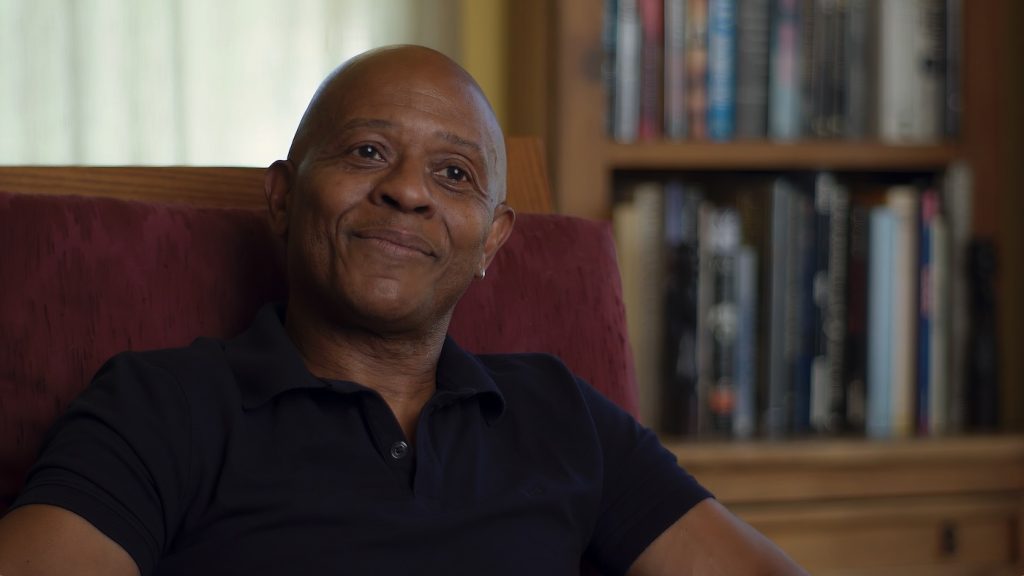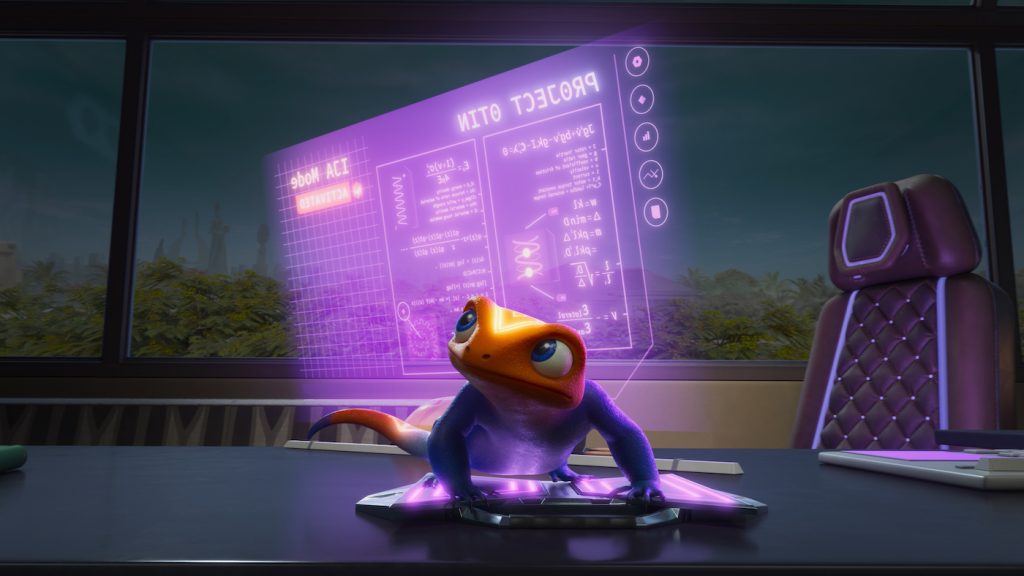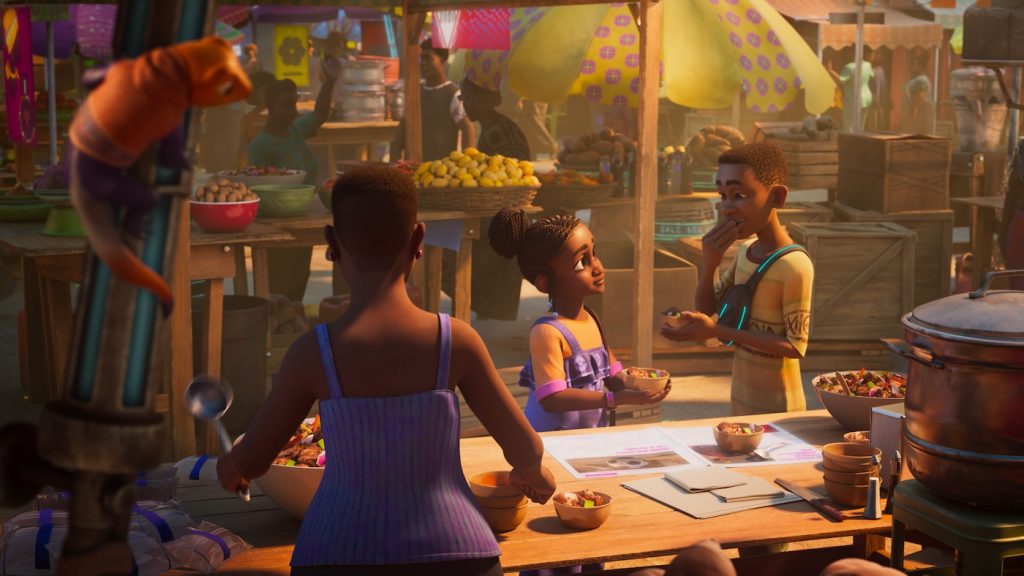“Iwájú” Visual Effects Supervisor Marlon West on Bringing Afrofuturism to Animation
Disney+ just released an exciting new 6-part animated series called Iwájú, representing the first collaboration with an outside studio in its partnership with Pan-African storytelling company Kugali Media. Kugali’s co-founders created a uniquely African story, which takes place in a futuristic Lagos, Nigeria. In fact, every single character that appears in Iwájú is Nigerian.
The series is a coming-of-age tale centered on an idealistic 10-year-old girl named Tola. She lives in the rarified and protected environment her tech mogul father Tunde has created on the island, the wealthiest part of Lagos. Her best friend, streetwise, self-taught tech expert Kole, lives with his mom on the overpopulated mainland in a makeshift dwelling. For her 10th birthday, Tunde gives Tola his best new tech, a defensive robot disguised as a simple lizard named Otin. When crime kingpin Bode and his henchmen, who have been terrorizing the people of mainland Lagos, set Tola as their target, it’s up to Tola, Kole, and Otin to save the day.
Marlon West, who was the visual effects supervisor for the project, described what the folks at Kugali were trying to say with the project. “It was actually a warts-and-all love letter to Legos, the hometown of two of the three Kugali founders, one of which still lives there.” All three founders took on leadership roles in the project, with Nigerians Olufikayo “Ziki” Adeola as director and Tolu Olowofoyeku as cultural consultant, and Ugandan Hamid Ibrahim as production designer. Their love of Lagos is expressed in Iwájú through everything from the production design to the characters and the way they speak to the joy characters in Iwájú seek in their everyday experiences. The Credits spoke to West about his part in the Disney/Kugali collaboration, as well as its Africanfuturism, examination of class inequality, and celebration of Black excellence.
After a decades-long career at Disney as head of effects animation, Iwájú is your first time in the role of visual effects supervisor. How is that different from what you’ve done before?
Most of my career was spent doing only special effects as a head of effects on several of our Disney films, like Encanto, Frozen, and Moana. The visual effects supervisor sounds like the same job, but it’s different in the sense that I’m in charge of everything visual to get our world from visual development drawings and paintings and storyboards to the final images you see onscreen. It’s going through the whole process. My job wasn’t just the visual effects, like the lightning and water and rain that I typically do, but everything that is part of the visual storytelling and the technical creation of the entire project of Iwájú.

This was a first for Disney in terms of collaboration, but they know animation, and Kugali knows Nigeria.
Kugali is a media company that primarily did comics prior to this project. They were first-time filmmakers, and it was their first time working in animation. They have wonderful artwork in their comics. We had Cinesite in Montreal as a partner studio that did the lion’s share of the production work, from assets to lighting. It was key that Disney leadership, myself included, made sure both Cinesite and Kugali were up to the game we usually play, and everyone was really excited to rise to that occasion.
In this story, technology plays a different part in the lives of each character.
We worked with production designer Hamid Ibrahim to make the technology specific to who is using it or what the source might be. Tunde’s tech is more legit because he created it himself. It has a purple hue, including what’s in his house and his car. With Bode, our fantasy backstory is that his glasses and cloaking devices and all the tech he uses is more hacked military tech as if it’s bootlegged. It’s blue and scratchy, and the avatar he uses is not at all off-the-shelf. It’s as crooked as he is, as far as where it comes from.

Otin has her own set of rules in terms of tech. She’s both a lizard and robot.
She’s an Agama lizard. I’ve never been to Lagos, but they’re ubiquitous there like squirrels are here in the states, so we tried to suggest that there are Agama lizards around their compound. Otin had to be believable to the rest of the world as just a lizard, but why would this little girl be making a pet of a lizard that is otherwise just everywhere? She has lots of tells that she is a robot. If you look really closely at her eyes, they are lenses. Her markings have lights that let you know if her batteries are low. She also doesn’t speak. Even when there’s audio coming out of her, she’s got a microphone. She doesn’t lip sync. That was a decision we made to make her feel more like a robot, and less like a character or a talking lizard. When she does speak, she’s just blank faced, and audio is coming from a speaker way in the back of her mouth.

There are a number of ways that Iwájú differentiates between those in power and wealth and those in poverty, right down to the colors used.
That was baked into how our people dressed, in our production design, and how they were able to experience life, like the difference between how Tola lives, versus how Kole lives. Kole’s dwelling doesn’t even have a front door. Here in the US a lot of cities use the expression “other side of the tracks” for the line between good and bad neighborhoods and in terms of living conditions. We’ve driven freeways through neighborhoods in America, and in Lagos, they have a physical island that’s a real geographical difference, where in the 50s they started filling in a lot of marshland and building really nice houses on that island. In the real Lagos there’s less of a clear divide between wealthy, middle and lower middle class people and where they live, but we leaned heavily into the physical divide. The haves are on the island, and the have-nots are on the mainland. We tried to use different colors, with earthy tones on the mainland, and pastels on the island, and clearly show different architecture in the two.
There are African patterns and symbols in a lot of the spaces, designs, and architecture in the show.
We really wanted to have these African patterns play a part in world-building, not only in people’s clothing but also in architecture. There are drum-shaped buildings. There are a lot of poor people on the mainland who live in stacked storage containers, and those have circles or squares, and when they’re stacked on top of each other, they make a pattern, especially at night. There’s overt design in the world by the architects and world builders of our futuristic Lagos, but there are also the implied African patterns, like in our scenes where two characters come head to head with each other. There are these patterns that come in. We wanted the tech to have an African feel, too, and not look at all like it’s coming from America but rather from Tunde’s company or one of his company’s rivals. It’s an African story and, even more specifically, a Nigerian story, and that is very much expressed visually.
What do you think is the best thing people will get out of seeing Iwájú?
I’ve seen a lot of people respond to the trailer like that reminded them of a famous Marvel property, and I think that is not a function of how much this looks like something else and more about how little we get so see science fiction with Black people. I really hope this expands that thinking because no one looks at Star Wars and says it’s just like Star Trek, but people look at this and say it looks like Wakanda. That’s because it’s so rare to see; it’s their only point of reference. When people see Tola, this rich African girl, for the first time, see her wake up on her 10th birthday, hop on her hoverboard, and play with her robot, they’re going to realize how much they need to see that. “I didn’t realize how starved I was to see the daughter of an African tycoon flying around in her futuristic pad. I hadn’t seen that ever before, and now I’m glad I have.” That’s in the first five minutes. There’s plenty more where that came from.
Iwájú is streaming now on Disney+.
For more stories on 20th Century Studios, Searchlight Pictures, Marvel Studios and what’s streaming or coming to Disney+, check these out:
The Game Has Changed: Jared Leto Enters the Grid in First “Tron: Ares” Image
“The Creator” Oscar-Nominated Sound Team on Blending Retro-Futurism, Robot Monks, & the Didgeridoo
How Pixar Director Peter Sohn Got Personal in His Oscar-nominated “Elemental”
Featured image: “IWÁJÚ” is all-new original long-form series created in collaboration with Pan-African comic book entertainment company Kugali. Kugali filmmakers Olufikayo Ziki Adeola, Hamid Ibrahim and Tolu Olowofoyeku call the series a love letter to Lagos, Nigeria. Their futuristic depiction is bursting with color, unique visual elements and technological advancements is inspired by the spirit of Lagos, which is physically divided into an island and a mainland separated by both water and socio-economic status. The coming-of-age story introduces Tola, a young heiress from the wealthy island, her best friend Kole, a self-taught tech expert and loving son from the mainland, and Tola’s calculating robotic pet lizard, Otin. “Iwájú” streams on Disney+ in 2024.



